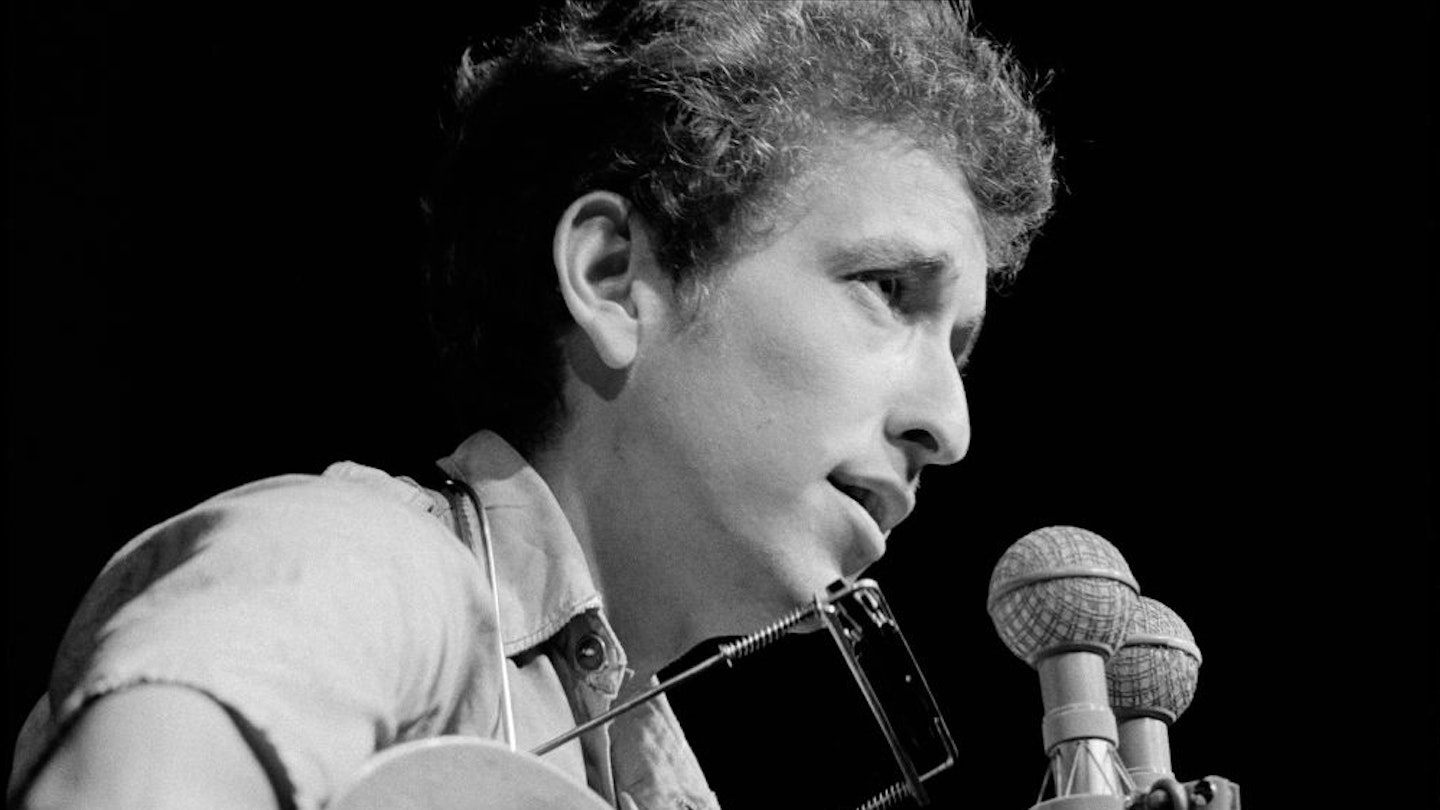26 July 1963
The first Newport Folk Festival for four years acts as a testing ground for the new breed of folkies – dubbed “Woody’s Children” by Pete Seeger.
‘Protest’ was the in word, with Tom Paxton, Phil Ochs, The Kingston Trio and Peter, Paul And Mary all questioning society’s attitudes to war, race and the ecology. But it was Bob Dylan, there for the first time, who delivered a whole compendium of songs making America and the wider world ask questions of itself. Dylan biographer Robert Shelton reported that Bob’s picture “was everywhere – lean, gaunt face, frail shoulders, covered in a faded khaki army shirt with wilted epaulets, blanched blue jeans. Most of the weekend he walked around with a long leather bullwhip wrapped tightly around one shoulder.”
His was the image that drew the world’s press. Little wonder why he’d been booked to play the festival’s honoured closing spot. Though there were supposedly no stars at Newport that year – everyone received the same $50 fee plus expenses – Dylan was the performer that many wanted to see, one reason why on the opening Friday night, July 26, over 13,000 people made their way to Freebody Park – equalling the attendance at the entire 1959 edition of the Rhode Island-based folk bash.
“I think this is one of Bob Dylan’s best songs. He sings it as a kind of hoarse chant, hardly more than two notes of the scale, one high and one low.”
pete seeger
They were an engaged crowd, clearly out for more than entertainment. Some 2,000 of them signed postcards to ABC-TV protesting about the blacklisting of Pete Seeger and The Weavers from the Hootenanny television show. Others read copies of Broadside, the 35-cent news and songsheet which had devoted that issue to Tom Paxton, Phil Ochs, Len Chandler and Peter La Farge. In its pages, Pete Seeger opined of Who Killed Davey Moore, “I think this is one of Bob Dylan’s best songs. He sings it as a kind of hoarse chant, hardly more than two notes of the scale, one high and one low.”
A shift was clearly becoming apparent. Ultimately, the Newport Folk jamboree, a non-profit operation sponsored by the Newport Folk Foundation, would be heard by a total audience of 46,000 over the course of its three evening performances and daytime workshops.
By comparison, its older brother, the Newport Jazz Festival, had drawn 36,000 for four evening concerts and various daytime events three weeks before. One of the jazz festival’s founders, George Wein, claimed the first night folk festival audience was the biggest for any Newport opening since the jazz festivals started in 1954.
Bob Dylan called to the stage Peter, Paul And Mary, Pete Seeger and Joan Baez...
Billboard magazine reported: “The opening night performance carried the dramatic highlight of the affair as well. It fell to Columbia’s fast-rising young singer-writer Bob Dylan to produce this episode. Reaching close to the finish of his closing spot on the bill, Dylan called to the stage Peter, Paul And Mary, Pete Seeger, Theodore Bikel, Joan Baez and The Freedom Singers from Albany, Georgia, all of whom lent a choral backup to Dylan’s rendition of Blowin’ In The Wind.”
Following this, Dylan stepped back into the semi-circle of celebrated performers and joined them in an inspiring reading of We Shall Overcome, which had become the national anthem of the integration movement. The folk revival was in full swing.
On Saturday evening (27) another 13,000 fans turned out for a concert highlighted by The Rooftop Singers, while Sunday (28) produced another sell-out crowd to watch Joan Baez perform by herself and later with Dylan in a rendition of With God On Our Side. Pete Seeger, who had performed the day before at the afternoon’s children’s concert, wrapped up the Sunday nighter.
Everywhere there was music to be heard, ranging from the blues, provided by such as Sonny Terry And Brownie McGhee, Mississippi John Hurt and John Lee Hooker, through to the country sounds of Doc Watson, Maybelle Carter and Doc Boggs, not to forget Tynesider Bob Davenport, who contributed what was hailed as “a heroic unaccompanied mining ballad”. Vanguard Records recorded everything that moved and eventually released six albums based on the event.
Even so, Dylan was the undoubted sensation of the three days, as was confirmed by two local record dealers Charles Lasky and Moss Music, who set up stalls in two tents at the rear of Freebody Park. They were well stocked with albums by all of the artists performing, but in no time the boxes filled with Dylan releases were left empty. The rapid sell-out prompted Lasky to claim: “I just didn’t realise how big he was.”
Bob Dylan Wins An Oscar! More in the MOJO Time Machine vaults...
